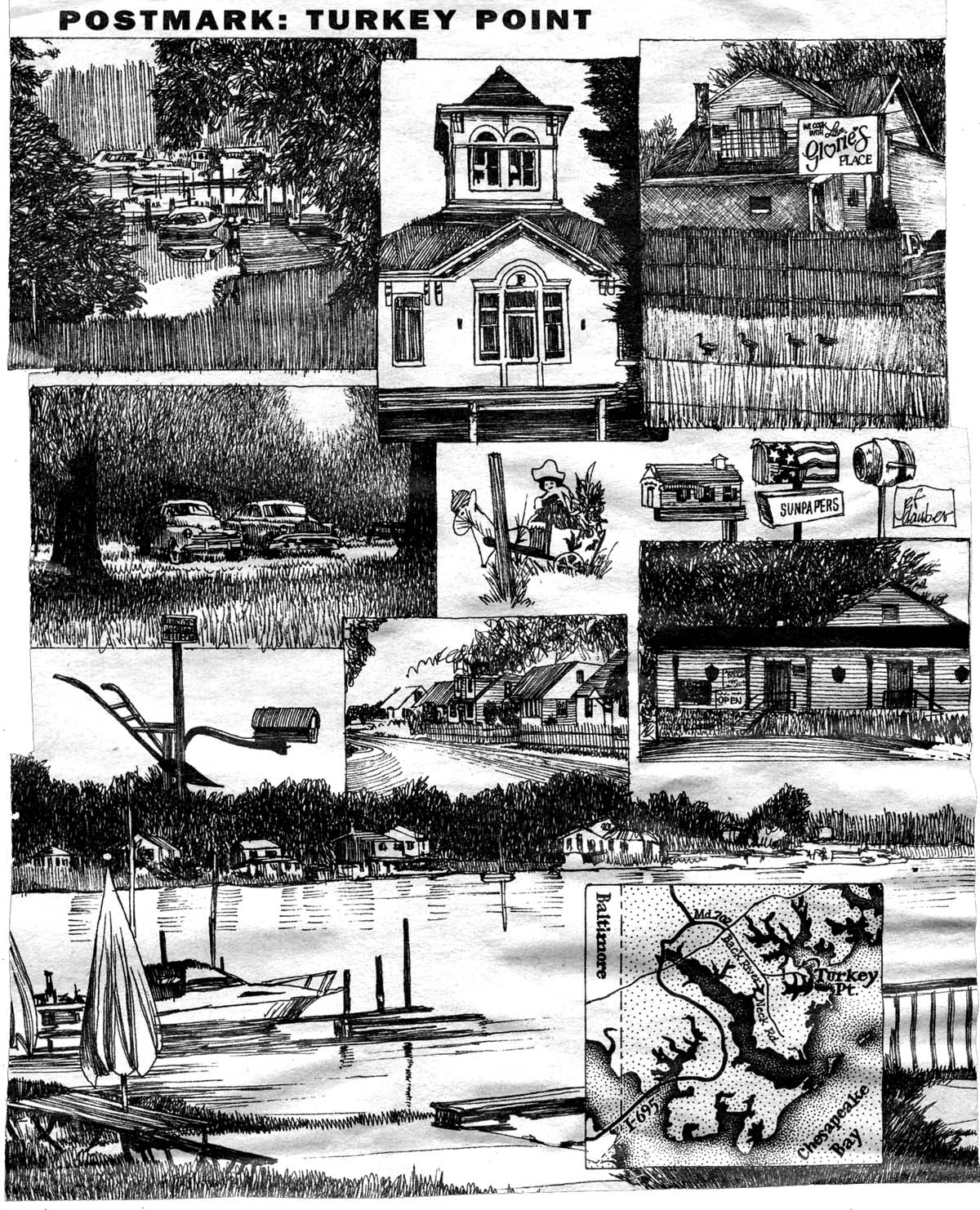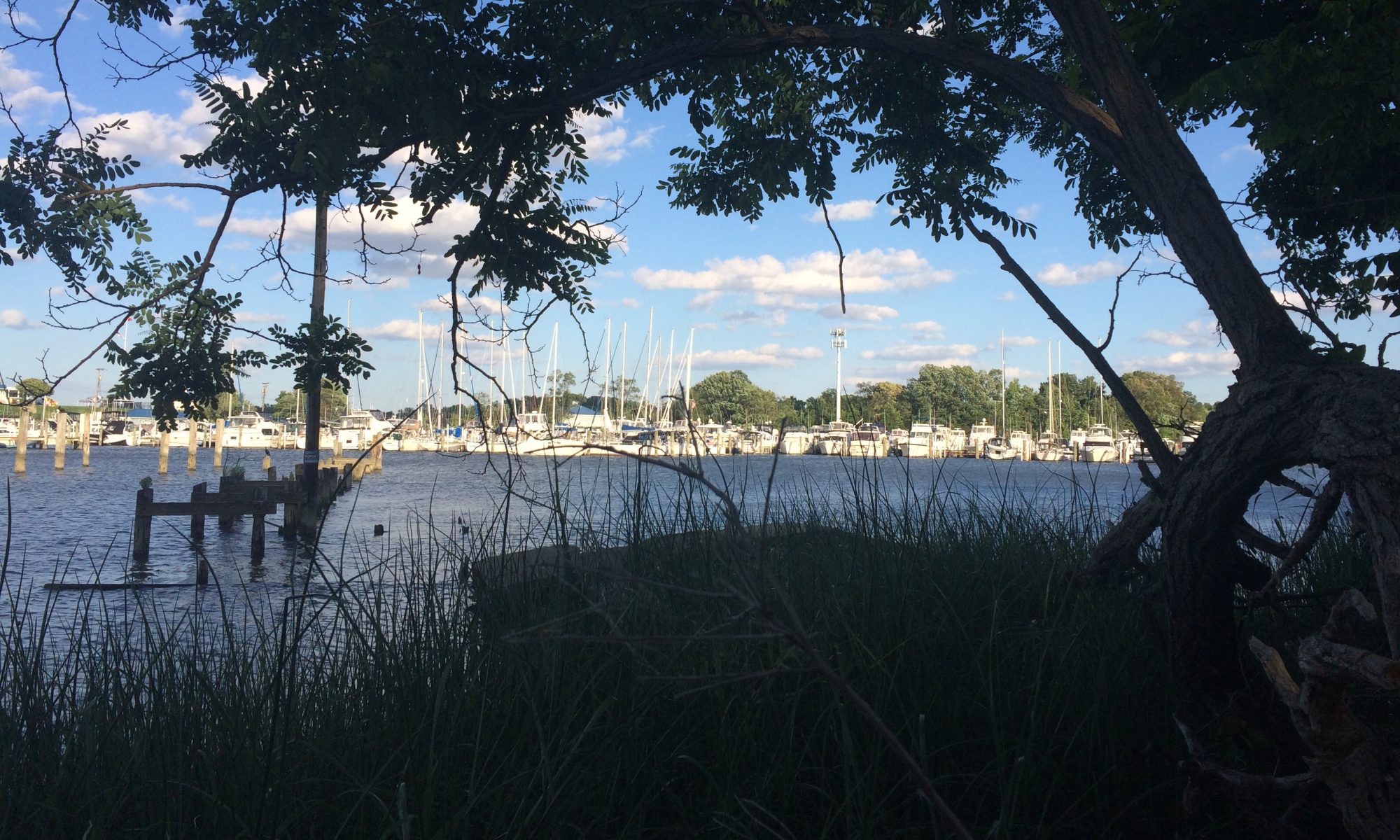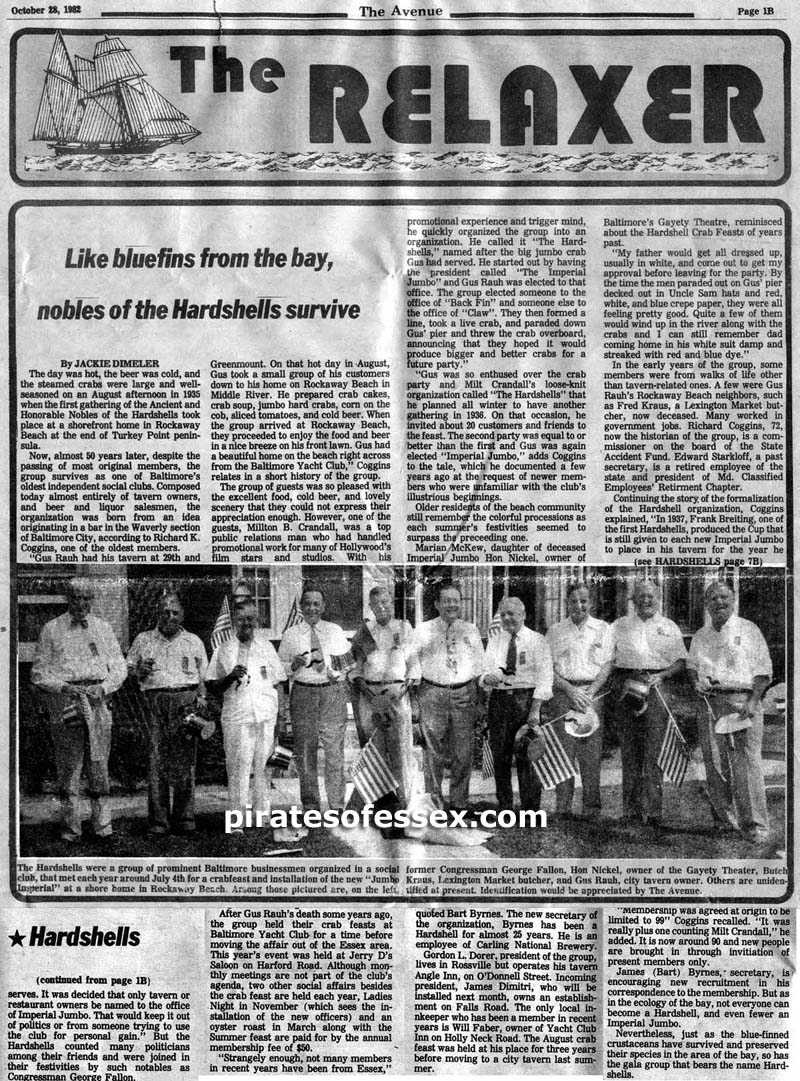Special thanks to Jimbo Buckler for putting together this photo gallery of Baltimore Yacht Club photos!
Turkey Point: Gobbling Up The Sweet Life

GOBBLING UP THE SWEET LIFE
By Rafael Alvarez (The Baltimore Sun, July 26, 1992)
All roads in Turkey Point end at the water.
“If you’re a lawbreaker and you get caught down here, there’s no way out,” says Pete Wert, who has passed more than half of his 75 years by the shores of Middle River where it flows past the end of Turkey Point Road.
“But if you’re looking for a place to get away from the hassle,” puts in L. E. “Jimmy” Ogle, “this is it.”
“But you’ve got more hassle than you did 10 years ago,” cautions Mr. Wert.
“It’s a forgotten little part of Baltimore County,” says Mr. Ogle, who has been a Turkey Point resident for 41 of his 60 years.
“Not so forgotten anymore,” says Mr. Wert.
Turkey Point is blessed with the sweet life — strong breezes, fresh air, quiet days and peaceful nights. Mr. Wert and Mr. Ogle spoke of the little community with reverence while hanging out with their good buddies at the Rockaway Beach Volunteer Fire Company at the end of Turkey Point Road.
“When I moved here in the early ’50s it was rural,” says Mr. Wert of the winding roads lined with thick, magnificent trees. “It was so rural I could drive down Back River Neck Road blindfolded. But since then a lot of people have been coming down here for cheap land.”
For a while now, doctors and lawyers and other professionals — people just a bit different from the men who hang out at the firehouse or the locals who put plaster statues of the Virgin Mary in their front yards — have been buying property in Turkey Point.
And not too very long ago a development of town houses went up near Chesapeake High, the neighborhood school.
“I think Turkey Point is probably still a well-kept secret; you can pick up properties down there from the low $100,000s to as high as a half a million,” says Debi Meushaw, a Realtor whose name appears on for-sale signs in the neighborhood.
Ms. Meushaw also talked about a piece of Turkey Point real estate known as Glorie’s Restaurant. “{It} is a wonderful place; they have the best oysters I’ve ever had. It’s a little home-cooking kind of place that brings a lot of people to the area.”
“This place has been here, I guess, for way over 50 years. We’ve had it for going on 14 years now,” Glorie Justice says while piling up plates of spaghetti and meatballs for a $3.50 lunch special. “It goes way back.”
Mrs. Justice, 58, was born in Essex, and her husband, Charles, 57, grew up in Highlandtown.
“We just love it here. The people here are so friendly and nice,” she says. “It’s a quiet, peaceful neighborhood. Everybody is very congenial. They help each other if the need arises. Years ago it used to be all shore homes — small, little shore houses — but the children and the grandchildren of the old ones who passed away have put up nicer, bigger homes.”
Those nicer, bigger homes share the community of Turkey Point with the Baltimore Yacht Club; a shady lawn for picnickers, the corrals of local equestrians at Turkey Point Park, and a dinner theater called Merrick’s.
They are all on the roads that end at the water. But there is no public access to the water.
For that you have to go about three miles away to Rockaway Beach.
And you might have to go farther to find anyone who remembers when wild turkeys roamed the woods.
“Wasn’t no wild turkeys here when I come,” says Mr. Wert. “Except for bootleggers over on Sue Island.”
Bauernschmidt Manor – ‘B’ is for Beer in Baltimore
‘B’ is for Beer in Baltimore
Brewers can trace history back to Essex, Middle River area.
By Keith Roberts (Essex Patch, 4/11/2011)
“…The Bauernschmidt families were very famous brewers of beer here in Baltimore. A tradition they brought with them from their Bavarian roots. George Bauernschmidt built a brewing empire in Baltimore starting in 1864 with the founding of his George Bauernschmidt Beer brand.
He continued the brewery for more than 30 years becoming one of the most popular brews in Baltimore, eventually bringing his sons into the operation. The years passed by and wanting to slow down and enjoy life a little more, George sold the business in 1898. The sale of the business; however, angered his son Frederick so much that the younger Bauernschmidt started his own brewery.”
Bauernschmidt Manor, a set on Flickr.
“…Fred and Agnes began building what we now call the Manor House sometime around 1905. It is rumored that bricks used for the foundation of the house came from buildings that were destroyed in the great Baltimore fire of 1904.
They lived in the home during summer months and hosted many parties and fundraisers there for their favorite charities. Many of Baltimore’s wealthiest residents attended these functions.
The large beautiful two-story home was probably completed sometime in 1906. It contained 15 spacious rooms and four fireplaces. The red slate roof was adorned with a huge cupola that was supported by brick columns 3 feet wide. The cupola offered a spectacular view of Middle River and the Chesapeake Bay. A large wrap-around, columned porch surrounds three sides of the building and that porch supports a balcony for the second floor.”
Read “‘B’ is for Beer in Baltimore” at Essex Patch.
Like Bluefins from the Bay, Nobles of the Hardshells Survive
By Jackie Nickel (10/28/1982)
The day was hot, the beer was cold, and the steamed crabs were large and well-seasoned on an August afternoon in 1935 when the first gathering of the Ancient and Honorable Nobles of the Hardshells took place at a shorefront home in Rockaway Beach at the end of Turkey Point peninsula.
Now, almost 50 years later, despite the passing of most original members, the group survives as one of Baltimore’s oldest independent social clubs. Composed today almost entirely of tavern owners, and beer and liquor salesmen, the organization was born from an idea originating in a bar in the Waverly section of Baltimore City, according to Richard K. Coggins, one of the oldest members.
“Gus Rauh had his tavern at 29th and Greenmount. On that hot day in August, Gus took a small group of his customers down to his home on Rockaway Beach in Middle River. He prepared crab cakes, crab soup, jumbo hard crabs, corn on the cob, sliced tomatoes, and cold beer. When the group arrived at Rockaway Beach, they proceeded to enjoy the food and beer in a nice breeze on his front lawn. Gus had a beautiful home on the beach right across from the Baltimore Yacht Club,” Coggins relates in a short history of the group.
The group of guests was so pleased with the excellent food, cold beer, and lovely scenery that they could not express their appreciation enough. However, one of the guests, Million B. Crandall, was a top public relations man who had handled promotional work for many of Hollywood’s film stars and studios. With his promotional experience and trigger mind, he quickly organized the group into an organization. He called it “The Hardshells,” named after the big jumbo crab Gus had served. He started out by having the president called “The Imperial Jumbo” and Gus Rauh was elected to that office. The group elected someone to the office of “Back Fin” and someone else to the office of “Claw”. They then formed a line, took a live crab, and paraded down Gus’ pier and threw the crab overboard, announcing that they hoped it would produce bigger and better crabs for a future party.
“Gus was so enthused over the crab party and Milt Crandall’s loose-knit organization called “The Hardshells” that he planned all winter to have another gathering in 1936. On that occasion, he invited about 20 customers and friends to the feast. The second party was equal to or better than the first and Gus was again elected “Imperial Jumbo,” adds Coggins to the tale, which he documented a few years ago at the request of newer members who were unfamiliar with the club’s illustrious beginnings.
Older residents of the beach community still remember the colorful processions as each summer’s festivities seemed to surpass the preceding one.
Marian McKew, daughter of deceased Imperial Jumbo Hon Nickel, owner of Baltimore’s Gayety Theatre, reminisced about the Hardshell Crab Feasts of years past.
“My father would get all dressed up, usually in white, and come out to get my approval before leaving for the party. By the time the men paraded out on Gus’ pier decked out in Uncle Sam hats and red, white, and blue crepe paper, they were all feeling pretty good. Quite a few of them would wind up in the river along with the crabs and I can still remember dad coming home in his white suit damp and streaked with red and blue dye.”
In the early years of the group, some members were from walks of life other than tavern-related ones. A few were Gus Rauh’s Rockaway Beach neighbors, such as Fred Kraus, a Lexington Market butcher, now deceased. Many worked in government jobs. Richard Coggins, 72, now the historian of the group, is a commissioner on the board of the State Accident Fund. Edward Starkloff, a past secretary, is a retired employee of the state and president of Md. Classified Employees’ Retirement Chapter.
Continuing the story of the formalization of the Hardshell organization, Coggins explained, “In 1937, Frank Breiting, one of the first Hardshells, produced the Cup that is still given to each new Imperial Jumbo to place in his tavern for the year he serves. It was decided that only tavern or restaurant owners be named to the office of Imperial Jumbo. That would keep it out of politics or from someone trying to use the club for personal gain.” But the Hardshells counted many politicians among their friends and were joined in their festivities by such notables as Congressman George Fallon.
After Gus Rauh’s death some years ago, the group held their crab feasts at Baltimore Yacht Club for a time before moving the affair out of the Essex area. This year’s event was held at Jerry D’s Saloon on Harford Road. Although monthly meetings are not part of the club’s agenda, two other social affairs besides the crab feast are held each year, Ladies Night in November (which sees the installation of the new officers) and an oyster roast in March along with the Summer feast are paid for by the annual membership fee of $50.
“Strangely enough, not many members In recent years have been from Essex.” quoted Bart Byrnes. The new secretary the organization, Byrnes has been Hardshell for almost 25 years. He is employee of Carling National Brewery.
Gordon L. Dorer, president of the group, lives in Rossville but operates his tavern Angle Inn, on O’Donnell Street. Incoming president, James Dimitri, who will be installed next month, owns an establishment on Falls Road. The only local innkeeper who has been a member in recent years is Will Faber, owner of Yacht Club Inn on Holly Neck Road. The August crab feast was held at his place for three years before moving to a city tavern last summer.
“Membership was agreed at origin to be limited to 99″ Coggins recalled. “It was really plus one counting Milt Crandall,” he added. It is now around 90 and new people are brought in through invitation of present members only.
James (Bart) Byrnes, secretary, is encouraging new recruitment in his correspondence to the membership. But as in the ecology of the bay, not everyone can become a Hardshell, and even fewer an Imperial Jumbo.
Nevertheless, just as the blue-finned crustaceans have survived and preserved their species in the area of the bay, so has the gala group that bears the name Hardshells.



































